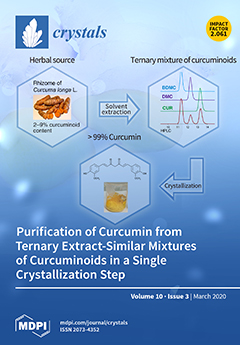The present study deals with the investigation of Cu
2+, Ni
2+ and Pd
2+ chelating potential of the Schiff base, (
E)-
N-(2-((2-hydroxybenzylidene)amino)benzyl)-4-methylbenzenesulfonamide (H
2SB). Crystal structures of Ni(HSB)
2, Pd(HSB)
2 and Cu(HSB)
2 have been
[...] Read more.
The present study deals with the investigation of Cu
2+, Ni
2+ and Pd
2+ chelating potential of the Schiff base, (
E)-
N-(2-((2-hydroxybenzylidene)amino)benzyl)-4-methylbenzenesulfonamide (H
2SB). Crystal structures of Ni(HSB)
2, Pd(HSB)
2 and Cu(HSB)
2 have been elucidated from single crystal X-ray diffraction data. NMR spectroscopy showed the presence of two conformers of Pd(HSB)
2 in solution, both with an
E configuration of the ligand. The determination of binding constants by fluorescence quenching showed that affinity of H
2SB to Cu
2+ in solution is higher than for Ni
2+ and Pd
2+. Since there is a high demand for selective, sensitive, rapid and simple methods to detect copper in aqueous samples (both as Cu
2+ ions and as CuO NPs), we have explored H
2SB as an optical chemosensor. H
2SB interacts with increasing concentrations of Cu
2+ ions, giving rise to a linear increase in the absorbance of a band centered at about 392 nm. H
2SB displays a high selectivity toward Cu
2+, even in the presence of the most common metal ions in water (Ca
2+, Mg
2+, Na
+, K
+, Al
3+ and Fe
3+), and some heavy transition metal ions such as the soft acids Pd
2+ and Cd
2+. H
2SB also interacts with increasing concentrations of CuO NPs, which gives rise to a linear decrease in its fluorescence intensity (λ
em = 500 nm, λ
ex = 390 nm). Quenching has occurred as a result of the formation of a non-fluorescent ground-state surface complex H
2SB–CuO NPs. The limits of detection and quantification of CuO NPs were 9.8 mg/L and 32.6 mg/L, respectively. The presence of TiO
2, Ag and Au NPs does not interfere with the determination of CuO NPs.
Full article





